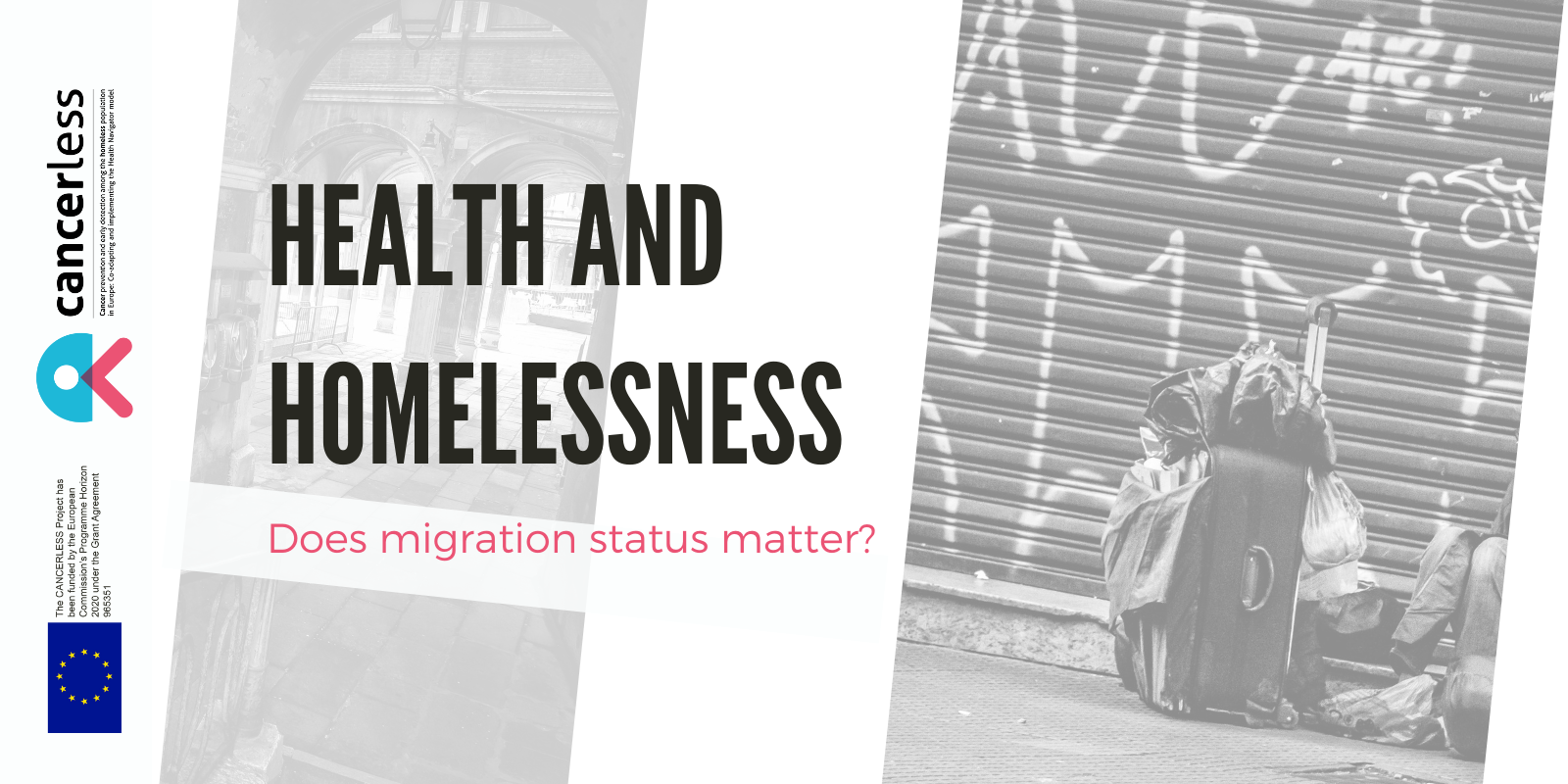Last month, we focused on masculinity and prostate cancer screening among homeless individuals in our blog. For the month of December, the CANCERLESS blog will focus on the dynamic and complex relationship between immigration and homelessness.
The Healthy Immigrant Effect
There are several studies examining whether immigration influences the health behaviour and health status of immigrants, with some studies noting immigrants showing better health outcomes in their first years in the host country. This is known as the “healthy immigrant effect” (Brabete, 2017). Some studies also considered if the same was true for homeless individuals and found similar results. Homeless immigrants were found to have some better health outcomes compared to the native homeless population. This was attributed to overall better health, younger age, better mental health status and lower levels of substance abuse issues (Tsai & Gu, 2019; Gil-Salmeron et al., 2021; Calvo et al., 2021). On the other hand, there is some evidence that suggests this effect is not stable over time, meaning that the longer people stay in their new country, the worse their health becomes until it is comparable to the native population (Chiu et al., 2009).
Health Access and Utilisation
While a number of positive health outcomes have been reported among recent immigrants, there seems to be a number of barriers and difficulties for this population when accessing the health care system. Commonly reported issues include legal barriers associated with residency status or access to health insurance. These are often compounded with cultural and language barriers which result in more issues when accessing appropriate level of care. This may lead to significantly lower utilisation of healthcare services in the immigrant homeless population when compared to native born individuals (Gil-Salmeron et al., 2021).
Additionally, the homeless immigrant population generally has less access to safe housing, often lives in more crowded accommodation and has significantly lower income compared to the native homeless population. These social issues are also risk factors for developing mental health issues (Lebano et al., 2020; Kaur et al., 2021; Gil-Salmeron et al., 2021). Moreover, recent immigrants reported that financial and housing reasons kept them from moving out of homelessness, whereas native homeless individuals primarily reported mental health issues and addiction problems as the main reasons (Chiu et al., 2009). Intersectionality plays an important role as homeless immigrant people tend to report more discrimination, not only based on their poverty or homelessness, but also due to racism
(Zerger et al., 2014).
Cancer Prevention
The homeless immigrant population also experiences specific barriers and problems in accessing cancer screening programs. A study by Huang and colleagues (2017), suggested that both immigration and homelessness are risk factors associated with reduced access to cancer screening programs. The factors may be compounded, meaning that non-native homeless individuals may also be more likely to miss appointments for cancer screening programs.
Practical considerations to reach immigrants in a situation of homelessness
Existing studies suggest differences in health outcomes as well as utilisation of health care when comparing homeless immigrants and native populations in the same circumstances. These are multifarious and etiologically connected creating a complex interplay of biological, social, cultural and legal issues. With a rise of immigration to the European Union, there comes a rise of homeless immigrant individuals, noting the need for tailored cancer prevention interventions that also focus on these legal, social and cultural aspects. One such approach may be the Health Navigator Model, which will take into account the specific living situations and realities of homeless people regardless of immigration status, and tailor the support offered to meet individual need.
References and additional literature
Brabete AC. Examining Migrants´ Health from a Gender Perspective. In: Sanchez-Lopez MP, Liminana-Gras RM. The Psychology of Gender and Health. Conceptual and Applied Global Concerns. Elsevier, 2017.
Calvo F, Turró-Garriga O, Fàbregas C, Alfranca R, Calvet A, Salvans M, Giralt C, Castillejos S, Rived-Ocaña M, Calvo P, Castillo P, Garre-Olmo J, Carbonell X. (2021). Mortality Risk Factors for Individuals Experiencing Homelessness in Catalonia (Spain): A 10-Year Retrospective Cohort Study. Int J Environ Res Public Health. 11;18(4):1762. doi: 10.3390/ijerph18041762. PMID: 33670288; PMCID: PMC7918849.
Chiu, S., Redelmeier, D. A., Tolomiczenko, G., Kiss, A., & Hwang, S. W. (2009). The health of homeless immigrants. Journal of epidemiology and community health, 63(11), 943–948. https://doi.org/10.1136/jech.2009.088468
Gil-Salmeron, A, Smith, L, Yang, L, Rieder, A, Grabovac, I. (2021). Differences in health status, health behaviour and healthcare utilisation between Immigrant and native homeless people in Spain: An exploratory study. Health Soc Care Community. 29: 856– 866. https://doi-org.proxy.library.uu.nl/10.1111/hsc.13313
Huang JL, Fang Y, Liang M, Li ST, Ng SK, Hui ZS, Ching J, Wang HH, Wong MCS. (2017). Approaching the Hard-to-Reach in Organized Colorectal Cancer Screening: an Overview of Individual, Provider and System Level Coping Strategies. AIMS Public Health. 22;4(3):289-300. doi: 10.3934/publichealth.2017.3.289. PMID: 29546218; PMCID: PMC5690455.
Kaur H, Saad A, Magwood O, Alkhateeb Q, Mathew C, Khalaf G, Pottie K. (2021). Understanding the health and housing experiences of refugees and other migrant populations experiencing homelessness or vulnerable housing: a systematic review using GRADE-CERQual. CMAJ Open. 18;9(2):E681-E692. doi: 10.9778/cmajo.20200109. PMID: 34145051; PMCID: PMC8248559.
Lebano, A., Hamed, S., Bradby, H. et al. (2020). Migrants’ and refugees’ health status and healthcare in Europe: a scoping literature review. BMC Public Health 20, 1039. https://doi.org/10.1186/s12889-020-08749-8
Tsai, J., Gu, X. (2019). Homelessness among immigrants in the United States: rates, correlates, and differences compared with native-born adults, Public Health. 168, 107-116
https://doi.org/10.1016/j.puhe.2018.12.017.
Zerger S, Bacon S, Corneau S, Skosireva A, McKenzie K, Gapka S, O’Campo P, Sarang A, Stergiopoulos V. (2014). Differential experiences of discrimination among ethnoracially diverse persons experiencing mental illness and homelessness. BMC Psychiatry. 14;14:353. doi: 10.1186/s12888-014-0353-1. PMID: 25496296; PMCID: PMC4275956.

